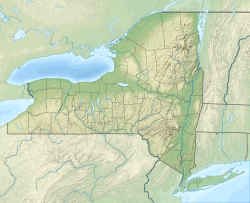
Back Shea Stadium CEB Shea Stadium Czech Shea Stadium Danish Shea Stadium German Shea Stadium Esperanto Shea Stadium Spanish Shea Stadium Basque Shea-stadion Finnish Shea Stadium French אצטדיון שיי HE
Shea | |||||||||||||||||||||||
 Shea Stadium in 2007 | |||||||||||||||||||||||
 | |||||||||||||||||||||||
| Full name | William A. Shea Municipal Stadium | ||||||||||||||||||||||
|---|---|---|---|---|---|---|---|---|---|---|---|---|---|---|---|---|---|---|---|---|---|---|---|
| Former names | Flushing Meadows Stadium (1961–1962)[1] | ||||||||||||||||||||||
| Address | 123–01 Roosevelt Avenue | ||||||||||||||||||||||
| Location | Flushing, Queens, New York | ||||||||||||||||||||||
| Coordinates | 40°45′20″N 73°50′53″W / 40.75556°N 73.84806°W | ||||||||||||||||||||||
| Owner | City of New York New York Mets | ||||||||||||||||||||||
| Operator | New York City Department of Parks and Recreation (1964–1981) New York Mets (1964–2008) | ||||||||||||||||||||||
| Capacity | Baseball: 57,333[2] Football: 60,372[3] | ||||||||||||||||||||||
| Field size |
 | ||||||||||||||||||||||
| Surface | Kentucky Bluegrass | ||||||||||||||||||||||
| Construction | |||||||||||||||||||||||
| Broke ground | October 28, 1961 | ||||||||||||||||||||||
| Opened | April 17, 1964 | ||||||||||||||||||||||
| Closed | September 28, 2008 (Final game) | ||||||||||||||||||||||
| Demolished | October 14, 2008 – February 18, 2009 | ||||||||||||||||||||||
| Construction cost | $28.5 million ($280 million in 2023 dollars[4]) | ||||||||||||||||||||||
| Architect | Praeger-Kavanagh-Waterbury[5] | ||||||||||||||||||||||
| General contractor | Carlin–Crimmins J.V.[6] | ||||||||||||||||||||||
| Tenants | |||||||||||||||||||||||
| New York Mets (MLB) 1964–2008 New York Jets (AFL / NFL) 1964–1983 New York Yankees (MLB) 1974–1975 New York Giants (NFL) 1975 St. John's Red Storm (NCAA) 2000 | |||||||||||||||||||||||
Shea Stadium (/ʃeɪ/ SHAY), formally known as William A. Shea Municipal Stadium, was a multi-purpose stadium in Flushing Meadows–Corona Park, Queens, New York City.[7] Opened in 1964, it was home to the New York Mets of Major League Baseball (MLB) from 1964 to 2008, as well as the New York Jets of the American Football League (AFL) and the National Football League (NFL) from 1964 to 1983.
The stadium was named in honor of William Shea, who was most responsible for bringing National League baseball back to New York after the Dodgers and Giants left for California in 1957. It was demolished in 2009 following the opening of the adjacent Citi Field, the ballpark built to replace it and the current home of the Mets. The former footprint of Shea Stadium is part of Citi Field's parking lots.
- ^ "History of Shea Stadium". New York Mets. Archived from the original on May 3, 2007. Retrieved February 24, 2020.
- ^ "Citi Field Side-by-Side Comparison". Major League Baseball Advanced Media. Archived from the original on April 22, 2021. Retrieved February 20, 2010.
- ^ Brown, Gerry; Morrison, Mike; Morrison, Michael (2007). ESPN Sports Almanac 2008: America's Best-Selling Sports Almanac. New York: ESPN. p. 583. ISBN 978-1-933060-38-5. Retrieved September 26, 2011.
- ^ 1634–1699: McCusker, J. J. (1997). How Much Is That in Real Money? A Historical Price Index for Use as a Deflator of Money Values in the Economy of the United States: Addenda et Corrigenda (PDF). American Antiquarian Society. 1700–1799: McCusker, J. J. (1992). How Much Is That in Real Money? A Historical Price Index for Use as a Deflator of Money Values in the Economy of the United States (PDF). American Antiquarian Society. 1800–present: Federal Reserve Bank of Minneapolis. "Consumer Price Index (estimate) 1800–". Retrieved February 29, 2024.
- ^ Cite error: The named reference
History of Sheawas invoked but never defined (see the help page). - ^ "Shea Stadium". Ballparks.com. Retrieved October 15, 2011.
- ^ Scanned picture Archived May 14, 2011, at the Wayback Machine of the dedication handout that shows the stadium is in Flushing Meadows–Corona Park.


